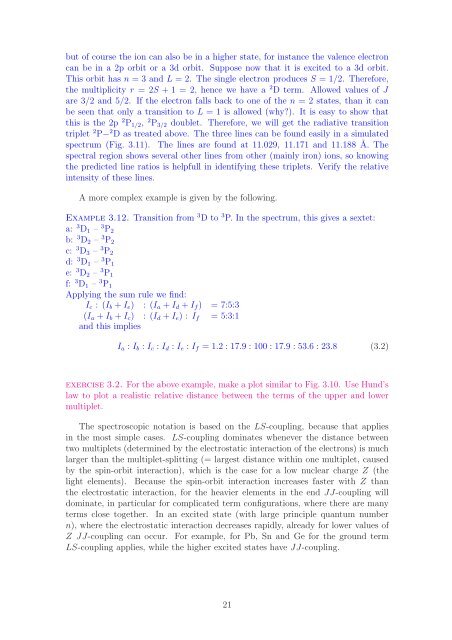Thermal X-ray radiation (PDF) - SRON
Thermal X-ray radiation (PDF) - SRON
Thermal X-ray radiation (PDF) - SRON
Create successful ePaper yourself
Turn your PDF publications into a flip-book with our unique Google optimized e-Paper software.
ut of course the ion can also be in a higher state, for instance the valence electron<br />
can be in a 2p orbit or a 3d orbit. Suppose now that it is excited to a 3d orbit.<br />
This orbit has n = 3 and L = 2. The single electron produces S = 1/2. Therefore,<br />
the multiplicity r = 2S + 1 = 2, hence we have a 2 D term. Allowed values of J<br />
are 3/2 and 5/2. If the electron falls back to one of the n = 2 states, than it can<br />
be seen that only a transition to L = 1 is allowed (why?). It is easy to show that<br />
this is the 2p 2 P 1/2 , 2 P 3/2 doublet. Therefore, we will get the radiative transition<br />
triplet 2 P− 2 D as treated above. The three lines can be found easily in a simulated<br />
spectrum (Fig. 3.11). The lines are found at 11.029, 11.171 and 11.188 Å. The<br />
spectral region shows several other lines from other (mainly iron) ions, so knowing<br />
the predicted line ratios is helpfull in identifying these triplets. Verify the relative<br />
intensity of these lines.<br />
A more complex example is given by the following.<br />
Example 3.12. Transition from 3 D to 3 P. In the spectrum, this gives a sextet:<br />
a: 3 D 1 – 3 P 2<br />
b: 3 D 2 – 3 P 2<br />
c: 3 D 3 – 3 P 2<br />
d: 3 D 1 – 3 P 1<br />
e: 3 D 2 – 3 P 1<br />
f: 3 D 1 – 3 P 1<br />
Applying the sum rule we find:<br />
I c : (I b + I e ) : (I a + I d + I f ) = 7:5:3<br />
(I a + I b + I c ) : (I d + I e ) : I f = 5:3:1<br />
and this implies<br />
I a : I b : I c : I d : I e : I f = 1.2 : 17.9 : 100 : 17.9 : 53.6 : 23.8 (3.2)<br />
exercise 3.2. For the above example, make a plot similar to Fig. 3.10. Use Hund’s<br />
law to plot a realistic relative distance between the terms of the upper and lower<br />
multiplet.<br />
The spectroscopic notation is based on the LS-coupling, because that applies<br />
in the most simple cases. LS-coupling dominates whenever the distance between<br />
two multiplets (determined by the electrostatic interaction of the electrons) is much<br />
larger than the multiplet-splitting (= largest distance within one multiplet, caused<br />
by the spin-orbit interaction), which is the case for a low nuclear charge Z (the<br />
light elements). Because the spin-orbit interaction increases faster with Z than<br />
the electrostatic interaction, for the heavier elements in the end JJ-coupling will<br />
dominate, in particular for complicated term configurations, where there are many<br />
terms close together. In an excited state (with large principle quantum number<br />
n), where the electrostatic interaction decreases rapidly, already for lower values of<br />
Z JJ-coupling can occur. For example, for Pb, Sn and Ge for the ground term<br />
LS-coupling applies, while the higher excited states have JJ-coupling.<br />
21
















